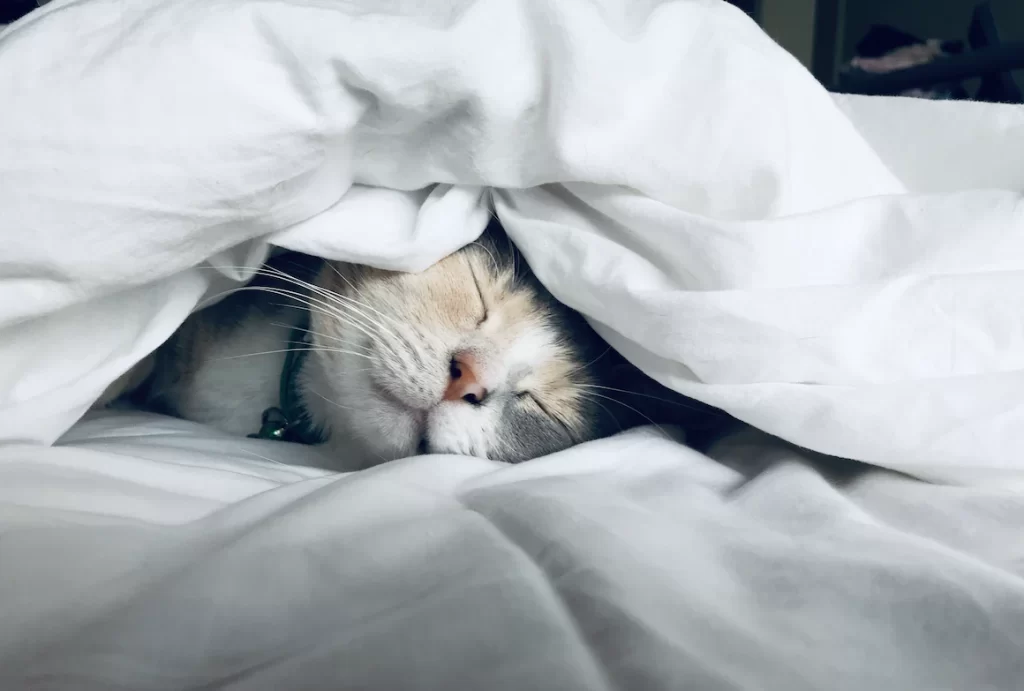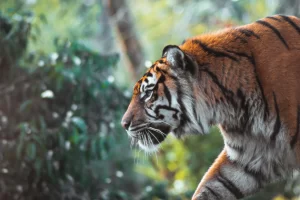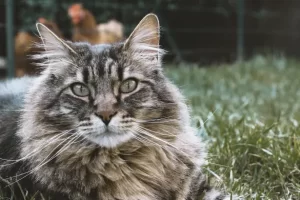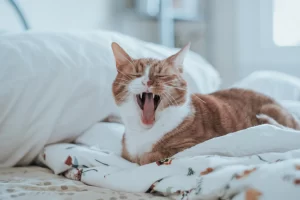Last updated on March 4th, 2023 at 11:22 pm

Around the world, millions of people have come to love cats for their intelligence and adorable demeanor. But do our furry feline friends understand what we are saying? Do they know how to show affection? And can they smile at us?
The answer to this question is a little complicated. Cats do not smile in the same way that humans do. In humans, a smile is usually associated with happiness or joy. However, cats are not capable of displaying this emotion in the same way.
According to Dr. Charles Mbogo, cats can display a facial expression that looks like a smile. This is known as a “flehmen response” or a “flehmen grimace.” It is a facial expression that cats make when they are feeling something that they don’t understand or can’t identify. In cats, this usually means they are smelling something that is unfamiliar or strange. This expression often looks like a smile because it involves the cat’s lips curling up at the corners, and their eyes narrowing. A cat’s smile can also be seen when cats are playing and enjoying themselves. While cats may not use the same facial expressions as humans do, their eyes, ears, and body movements are all ways of communicating with other cats and people. Cats that are enjoying themselves may have their eyes half-closed, with their ears pointed forward and their mouth slightly open.
Experts in animal behavior believe cats show their emotions through body language so people can understand their feelings more easily. Large cats, such as big cats and lions, are believed to be more in touch with their emotions and are much more likely to express their feelings by acting out violently and aggressively.
However, although most cats that have undergone skill tests have shown great ability, some have failed. The cats that showed the most intelligence were a border collie and a poodle, and those that failed the most were feral cats.
It is also important to note that many pet owners do not understand their animals and their feelings. Cats cannot tell us in words what they feel, so it is up to you to read your cat’s body language and recognize his or her moods and feelings.
A cat can show his happiness and gratitude through gestures, such as purring or curling up in your lap. In addition, Dr. Bradshaw claims that you should recognize when your cat is feeling low and try to give him or her some extra affection or playtime.
Cat lovers around the world are getting more and more connected to their feline friends every day. However, if you do not take the time to understand your cat’s basic emotions, you may never know what he is thinking.
How do Cats Smile?
Cats are known for their mysterious, often inscrutable nature. They often seem to be deep in thought or have a secret they’re not willing to share. This is why it can be so charming when a cat smiles, often with a wide open mouth and a twinkle in its eye. Though cats can’t physically smile in the same way as humans, there are certain behaviors that signal that a cat is happy and content.
When cats are content, they may display relaxation postures such as lying down with their legs splayed out or curling up in a tight ball. They may also stretch out their bodies, purr, knead their paws on the surface they are lying on, and gently knead their owners. All of these behaviors signal contentment, and can be interpreted as a cat’s way of smiling.
Another way cats can physically smile is through the positioning of their ears. When cats are content or relaxed, they may have their ears slightly back and inwards. This is a sign of submission and can be seen as a smile. Cats may also tilt their head to the side, which is a sign that they are content and listening.
When a cat is happy and satisfied with life, he or she will often give you a sideways, upside-down smile. That is how your cat expresses contentment, whether in response to food or playtime with you. A pet owner might witness this during a happy routine of feeding and playing with their cat to show affection for their love and devotion.
A cat will also smile when your pet is happy with you. Cats are true companions and do not judge a person based on their position in society. As long as he or she is satisfied with you, your cat will feel love in return and express that by smiling at you.
Smile at a cat; he will probably respond to you with a wider version of the same expression. This is how cats communicate to one another that someone is pleased about something, whether it’s food or affection.
Pet owners also need to recognize how cats express their happiness. When your cat does smile at you in return, you should reward her or him by petting him or her and showing your appreciation. If you have been neglecting your cat, it is unlikely that he or she will do the same just because you hug and play with it. Cats are true companions and do not judge a person based on their position in society.
Signs of a Happy Cat
How can we tell if our feline friends are happy if they do not show their happiness by smiling?
- Purring
Purring is a common sign of contentment in cats and can mean that they are happy. Generally, cats purr when they are content and relaxed, such as when they are being petted, fed, or playing. In addition, a happy cat may knead its paws or rub against you when you interact with it. If your cat is purring, it is likely a sign that it is feeling content and happy.
- Meowing
Meowing is one of the primary ways cats communicate with humans. A content cat will usually have a soft, low-pitched meow. If the meow is louder, more frequent, and higher-pitched, it may mean the cat is feeling anxious or frustrated. If a cat is meowing excessively and displaying any of these signs, it is likely they are feeling happy.
- Tail
If your cat wags his or her tail, he or she is in a good mood. The position of the feline’s tail might also reflect his or her feelings. A happy cat will hold its tail high and straight out behind him, while a cat afraid or unsure of something keeps its tail tucked between its hind legs.
- Eyes
If a cat has slitted eyes, it may be a sign of fear or aggression. A happy cat will also have bright eyes, with the whites being clearly visible, and the pupils responding to light. Furthermore, when a cat is happy, its eyes will often be half closed as a sign of contentment. If you notice your cat’s eyes twinkling, it’s a sure sign that your cat is feeling good.
- Piloerection
Piloerection is when cats raise their fur, or “fluff up” their fur. This is often a sign of fear, but can also be a sign of contentment. When cats are happy, they will often do this while purring and rolling around, or even rubbing against an object or person. If a cat is feeling fearful, they may also display piloerection, but this is often accompanied by other signs of fear, such as wide eyes, crouched body, and a fast-moving tail.
- Kneading
Kneading is another way that cats express their happiness. When a cat kneads, he or she will push his or her paws down and pull them up on an object, such as a blanket. This is a behavior that felines exhibit when they are happy, and it is thought to be an instinctual behavior from when their mothers nursed them.
- Belly
Exposing her belly to you is one of the highest compliments a cat can pay you. After all, a cat is most vulnerable on her back. This is a sign that she completely trusts you — a kitty smile. You should be very proud! Another reliable indicator of trust? When your cat blinks at you steadily and calmly. Aww. What could possibly be better than that?
- Ears
One way to tell if your feline friend is happy is to observe their ears. If their ears are up and forward, it is likely that your cat is relaxed and content. If their ears are pointed in different directions, it is a sign that they are alert and ready for action. By observing your cats’ ears, you can get a better understanding of their mood and overall comfort level.
Is It Okay To Smile At My Cat?
Absolutely! Smiling at your cat is a great way to show them affection and show them that you care. Cats are very social animals, and they love to interact with their owners, so smiling at your cat is a great way to communicate with them.
A secure kitty is unlikely to react to your facial expressions, whether you are smiling or frowning. If you smile while giving your kitty slow blinks (because it’s nearly impossible to give slow blinks and not smile), they may respond with similar intent—giving slow blinks, or even an arched back. A contented kitty recognizes and trusts you as the person to whom they are bonded. And this is a lovely thing.
If you have a new kitty or a cat who is timid or scared, a smile can serve as a reminder to be calm and gentle with the noises and actions you make. Cats who have not yet bonded with someone or who do not feel completely safe will be terrified by loud voices and quick movements. Maintaining a gentle demeanor as you get to know your cat—or making him feel secure enough to break out of his shell—can help ensure you maintain the gentlest of demeanors. All of this being said, if you approach a cat (even your sweetest long-time love bug) and squint your eyes, bare your teeth, and hiss at them, you might get exactly what you give. This is not a good idea for anyone. Maintain a positive attitude! Smiling allows us to connect with others, including our cats. Though they may not be smiling back at us, there are numerous ways they can express their happiness. Fortunately for us, these are fairly simple to identify, support, and participate in.
Smiling at your cat can also help them to learn how to interact with you, as they will begin to recognize your facial expressions and body language. This can help them to understand when they’re doing something right, as well as when they’re doing something wrong. This can help to strengthen the bond between you and your cat, making it easier for you to communicate with your pet and train them.
Different Cat Expressions That Aren’t Smiling
It’s impossible to deny that a cat’s face is nothing short of magical. That tiny nose. Those wide-eyed stares. That tiny pink tongue. I sighed. But, aside from being adorable, what can cats tell us with their adorable faces? Here are four expressions you might have noticed on your cat’s face that could be mistaken for—but aren’t actually—happy smiles.
Resting Smile Face
Resting Smile Face is simply a humorous term for how most cats’ faces appear. Cats usually appear to be smiling because their mouths turn upwards at the corners. There are “grumpy cats” in the world, but a cat’s most expressionless face will look a little smiley.
Furrowed Brows
When a cat is unhappy, he or she will often furrow its brow and pull its ears back. This could indicate that they are afraid, feel threatened, or are attempting to appear tough in the face of adversity.
Flehmen’s Reaction
The Flehmen Response, also known as “stinky cat face,” is the scientific term for the open-mouthed, huffy sniffing that cats can sometimes do. This may appear to be a smile or even a grimace, but it is simply a way for a cat to improve its sense of smell. Cats (and many other animals) have scent receptors on the roofs of their mouths, and this open-mouthed huffing is simply a way for them to get a better whiff of what’s out there in the world.
Exposed Teeth
Cats will show their teeth not only to smell but also to warn. This can appear as a big open-mouthed smile at times, but it usually means “back off.”
Conclusion
The answer to “do cats smile?” requires quite a bit of explanation and digging. While they don’t necessarily show it in the same way humans do, cats are capable of displaying positive facial expressions in response to positive stimuli. While cats do not have the same facial muscles as humans, they are able to express themselves through different facial expressions and body language. Research has shown that cats can show signs of happiness and contentment by purring and raising their tails, and even displaying a genuine smile.


